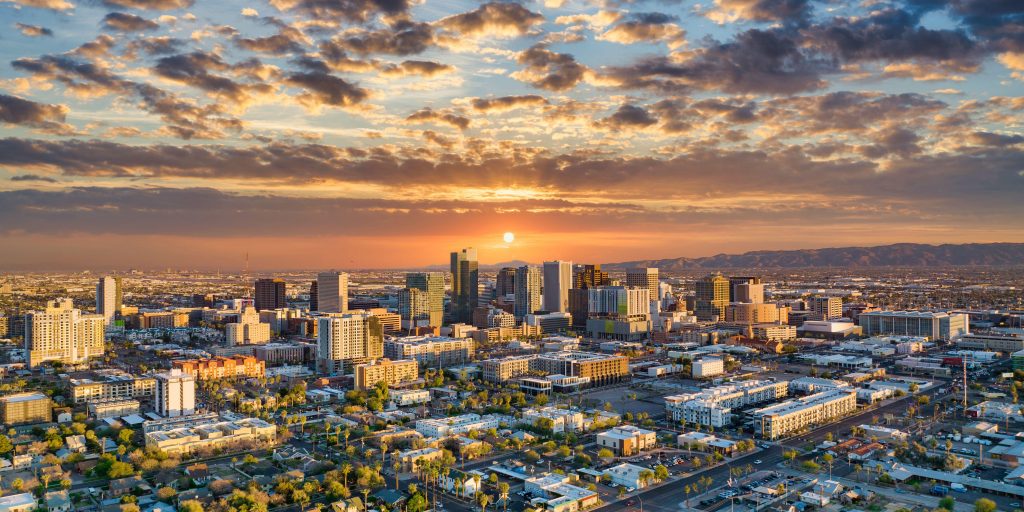Federal funds help fast-growing Arizona city address several infrastructure challenges and needs
Joe Giudice, public works director for the city of Phoenix, says the influx of new residents is driving a lot of construction in his community. “Phoenix is the fifth largest city in the United States. It is one of the fastest growing cities in a fast-growing region, which influences infrastructure product and service demand. This growth includes a significant amount of new construction and redevelopment in high-tech industrial, commercial and residential.”
He adds that there is something else propelling his city’s expanding skyline. “Infrastructure product and service demand is not only influenced by the significant growth, but also the funding made available through the federal government during the pandemic, and now through legislation such as the Infrastructure Investment and Jobs Act (IIJA), and the Inflation Reduction Act.”
Giudice says these federal initiatives will help meet some targeted needs in his community. “These legislation priorities and investments address resiliency, impacts of climate change, adoption of electric vehicles, energy efficiency and other sustainability and multi-modal transportation-related projects.”
Giudice has spent nearly two decades in municipal government in Arizona. In the Phoenix municipal government, he has served as environmental programs administrator and assistant water services director. More recently, Giudice served as the assistant public works director, responsible for leading the solid waste division, which provides direct services to more than 400,000 Phoenix households, while overseeing an annual budget of approximately $160 million and more than 600 employees. He was named the director of the public works department in August 2021.
Giudice is committed to Phoenix’ mission, which includes aligning priorities with the American Public Works Association (APWA). The group provides a voice and education for all public work professionals who plan, design, build, maintain and operate infrastructure networks in the U.S. The APWA is a nonprofit, professional association of public works agencies, private companies, and individuals dedicated to promoting professional excellence and public awareness.
Giudice is a member of the APWA Solid Waste Management Committee. He is working to ensure that his city remains committed to long-range planning strategies in sustainability and environmental protection.
In 2023, Giudice says his city will be acquiring and installing traditional infrastructure to support a growing community, such as concrete, asphalt, water and sewer piping, as well as HVAC and electrical systems. In addition, Phoenix will continue to install heat resiliency products and services. “We live in a desert city and want to ensure a sustainable community that mitigates heat for the population. For example, we are relying on cool pavement, trees and shade, and cool building materials and surfaces to help mitigate heat.” Some examples of heat resiliency products and strategies that Phoenix has installed or is considering are products that increase shade around city buildings; installation of green roofs and cool roofs on city facilities; and adding more trees and vegetation to help reduce urban heat island effects by shading building surfaces, deflecting radiation from the sun, etc.
Giudice says investments in green infrastructure are a priority in Phoenix, and discussions about green infrastructure have been held at recent bond program meetings with elected leaders and community members.
He notes that the emphasis on heat-effects mitigation is wide-ranging. “The priority on heat resiliency and reduction is not only around city buildings, but also throughout the community in city right of way and parks, with a focus on areas of the city that are deficient in shade. Furthermore, city officials are considering making updates to building codes to require or incentivize developers to achieve these heat resiliency objectives.” Giudice adds that Phoenix recently created an office of heat response and mitigation, led by a heat resiliency director.
Another heat resiliency tool that Phoenix is considering is cool pavement. It has undergone some successful early testing. Cool pavement coating reflects a higher portion of the sunlight that hits it, thus it absorbs less heat. Because of this higher reflection, the coating has the potential to offset rising night-time temperatures in the Phoenix region.
In the first year of a performance study done by scientists at Arizona State University’s (ASU) Global Institute of Sustainability and Innovation, Healthy Urban Environments, and the Urban Climate Research Center, results are promising. The study revealed that in the test product, reflective pavement surface temperatures are considerably lower than traditional roadway pavement. Cool pavement revealed lower surface temperatures at all times of the day versus traditional asphalt.
Giudice predicts a few areas where his city’s infrastructure will see upgrades in 2023, including:
- Water usage efficiency. “We have adapted to a desert lifestyle and prioritize water-efficient fixtures and landscapes, water reclamation and reuse, and production and storage of water for an assured long-term water supply.”
- Energy efficiency and renewable energy production. Products and services that reduce energy consumption and/or provide alternative energy such as solar will continue to be improved and updated in 2023, Giudice predicts. “For example, the city expects to make additional lighting and energy management system upgrades and invest in additional solar/renewable energy.”
- Asset management. The Phoenix public works director notes that this continues to be a hot topic. “More local governments are investing or upgrading technologies to manage assets more effectively. Asset management technologies continue to evolve and this will continue to be a focal point for 2023 investments and beyond.”
- The Homelessness Crisis. Giudice explains that Phoenix and many other large cities are dealing with growing populations of unhoused families. “Shelters, low-income housing, and public infrastructure to support the needs of that population will continue to be a trend for municipal investment.”
When considering acquiring infrastructure and other products and services, local governments may want to look at using cooperative contracts, Giudice says. “Cooperative contracts can serve as a great tool to assist local jurisdictions in the procurement of products and services. Each jurisdiction, however, has its contractual and legal requirements, which can sometimes be an impediment to cooperative agreements.”
He offers this advice to organizations that provide those services: “Get to know the procurement staff and their policies at each local jurisdiction and help them navigate the cooperative by being flexible with terms.”
OMNIA Partners Public Sector lists about a dozen cooperative contracts with “Infrastructure” as the keyword at this site.
Michael Keating is senior editor for American City & County. Contact him at [email protected].




















